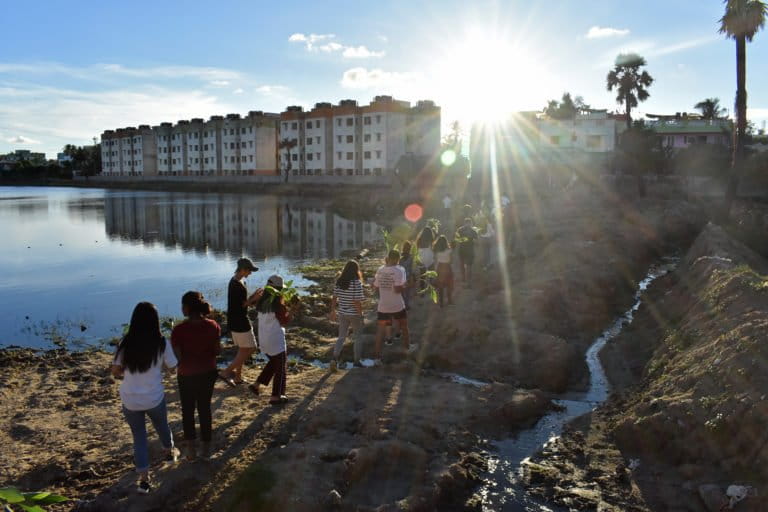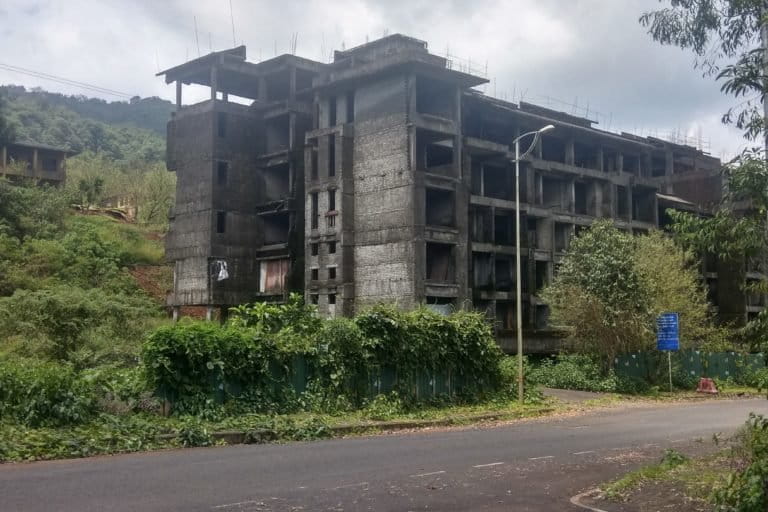- For a generation of environment journalists since the early 1990s the story was about the environmental consequences of economic growth. Now, for the first time we are facing the situation of reporting on the environment as the economy decelerates.
- As we keep our focus on the environmental story within the economic reality, we also do not want to lose sight of those individual, community or organisational actions that, though small, can set an example for others to follow. New realities also offer scope for innovative solutions.
- Mongabay-India’s two new series, ‘Environomy’ and ‘Eco Hope’, will look at the environmental impacts of economic deceleration on one hand and the solutions that individuals, communities and organisations are innovating to deal with the environmental problems.
The Rajiv Gandhi government had passed its prime when I started practising journalism in 1987. Even though by then the political situation was getting difficult for Gandhi, he had laid the foundation of his vision of economic growth for the country. The technology missions had identified the problem areas for the country and were developing plans of action to deal with them.
Gandhi’s ability to drive the economy, however, was not as good as his ability to dream of its growth. There was an economic decline that led to the balance of payment crisis of 1990-91, which in turn led to the launch of the economic reforms.
If 1991 was a milestone for transition to economic growth in India, we are currently going through another period of change, this time in the reverse direction. The transition was abrupt and government-defined in 1991. The current transition is gradual and the national government is in denial.
The language of development and growth has been well-ensconced in the national mainstream since 1991. Running along this economic story was that of the environment. Economic growth or otherwise has a bearing on the environment.
For a generation of environment journalists since the early 1990s the story was about the environmental consequences of economic growth. This is the first time we are facing the situation of reporting on the environment as the economy decelerates. The new lens through which we need to look is of the environmental consequences of economic decline.
The latest figures say that India’s GDP growth rate during the July-September 2019 quarter had fallen to 4.5% compared to 5% in the previous quarter. If 2019 was bad for the economy, all indications are that the decline may run for some time in the near- and medium-term future.
The real estate sector, which usually pulls the economy, has been tottering since the demonetisation of November 2016. The automobile sector, which again helps the growth of ancillary industries, has been facing a downhill slope in the past couple of years.
All these have resulted in a loss of jobs. According to the Centre for Monitoring of Indian Economy (CMIE), there has been a continuing fall in job markets and even medium and large companies are laying off workers (they had not done so even during demonetisation).

A safety net that isn’t there
It is a double whammy when environmental issues combine with fall in incomes. On the one hand, there is morbidity caused by pollution, and on the other, there is no money to treat the ailments.
To make matters worse, it is not as if India had moved up dramatically in its Human Development Index (HDI) so that there is a social cushion for the economic decline. As per the latest Human Development Report from the United Nations Development Programme, India is ranked 129 in the global listing on the HDI, sandwiched between Nicaragua and Namibia.
In the early years of the economic reforms in the 1990s, the then finance minister Manmohan Singh used to oft repeat his belief that when the economy would grow by 7% there would be money that could be used for the social sector growth. India’s HDI value grew from 0.431 in 1990 to 0.647 in 2018. For computing the HDI the UNDP uses these indicators – life expectancy at birth, expected years of schooling, mean years of schooling and gross national income per capita.
Between 2013 and 2018 India moved up by one rank in the index rankings. However, it is still in the middle HDI group of nations. Obviously, despite India’s growth in HDI and economic growth above 7%, the 129th position does not reflect the country’s position as an emerging economy.

The triangle of impact
What the liberalisation had infused was a sense of “can do” confidence among Indians, which is being stolen, step by step, with the economic decline. Trapped by governmental controls and near-negligible growth rates, there was a diffidence that lasted for decades since Independence. The reforms since 1991 gave a sense of economic identity to the middle class.
So much so that there was an increasing number of Indians self-identifying themselves as the middle class or aspiring to be part of it. Thus when the dryland farmer in Dharmapuri district of Tamil Nadu struggled and sent his son to a private engineering college so that he could get a software job in Bengaluru, it was this aspiration at play.
There was a sense of confidence in the Indian economy, which was further bolstered when our banking system came out unscathed when the subprime lending crisis in the US had shaken many other economies in 2008. Designing a sign for the Indian rupee was seen as an indication that we had arrived.
It is this mojo that is taking a beating with economic decline. For a generation of youngsters who had taken campus recruitment as almost a birthright, the prospect of not having the opportunity of employment is bringing back a despondency that their parents had faced in the decades before the 1990s.
In a way, Manmohan Singh was right when he said that if there is economic growth then Indians will think about social indicators. Add environmental concern as a social indicator, then post reforms there was a new sense of environmentalism. It was internalised much better by the middle classes than at the time of the anti-Narmada and anti-Tehri dam protests. Those protests were seen as something somewhere far away by tribals and villagers. But floods in Chennai or Mumbai were not something far away, happening to somebody else. Or for that matter bad air worsening your child’s asthma in Delhi.
After the excitement of the growth in the Nineties and the Noughties, there was a realisation of its environmental cost implications as extreme weather events became more frequent and severe. Even earlier, environment had become a cause for many – citizens’ groups, NGOs, scientists, lawyers and judges. “Let’s do something about our environment” was as popular a statement as “we need to do something about our population problem” was in the 1970s.
However, the question is whether these concerns will continue as jobs become less and incomes dwindle. Would the Bengaluru techie be as interested in wearing plastic gloves and cleaning the neighbourhood lake when she is unsure about her next month’s salary?

Returning to irreversible change
While with increasing incomes there was an interest in environment among the middle class, the growth that had brought more money had also destroyed natural resources. Making the situation worse are the increasing vagaries of climate change.
Market economics turned natural resources into commodities so that they could be brought into the market. Land was parcelled for real estate development. This meant that wetlands, flood plains of rivers and mangrove swamps were “put to better use” and converted for industrial and housing projects. Highways were built across farms and forests. Aquifers were extracted and the water sold to cities in tankers and plastic bottles. Rivers were dammed to prevent even the minimum environmental flow did not go into the sea.
With increasing urbanisation and the growth of tier 1 to tier 3 cities, the centres of consumption increased. While agricultural produce, manufactured goods and services moved from the hinterlands to the cities, the urbanite was far removed from the environmental consequences of this consumption.
As the employment opportunities reduce and the pull factor from the cities turn more into a push out, even a return to the roots will be difficult as an option. The natural resources that sustained rural communities in the past may not be available. For the son of the Dharmapuri farmer even the meagre productivity of his family farm would have reduced further due to multiple droughts, and plastic wastes would have made the village tank unusable.
Unable to take construction and industrial projects to their logical conclusion, there are already innumerable stranded assets in urban and peri-urban areas. The impact of these buildings are two-fold. They would have caused land use change under the promise of improved financial returns, which now seems distant in the time horizon in the current economic scenario.

Reality and hope
At the beginning of this year and decade, we at Mongabay-India are starting two series. Named ‘Environomy’ and ‘Eco Hope’, one will look at the environmental impacts of economic deceleration, the other will report about solutions that individuals, communities and organisations are innovating to deal with the environmental problems.
There are stories – like that of the lady from the Rabindra Sarovar, the forester protecting Mumbai’s mangroves, or the innovator in Assam who found ways to enthuse villagers to conserve the house sparrow – of working against odds to conserve their natural resources from destruction. These actions hold out hope and also enthuse others to follow their examples. Our Eco Hope series will focus exclusively on these stories.
As we keep our focus on the environmental story within the economic reality, we also do not want to lose sight of those individual, community or organisational actions that, though small, can set an example for others to follow. New realities also offer scope for innovative solutions.
Banner image: The economic slowdown is bringing out new environmental realities. Photo by S. Gopikrishna Warrier/Mongabay.
